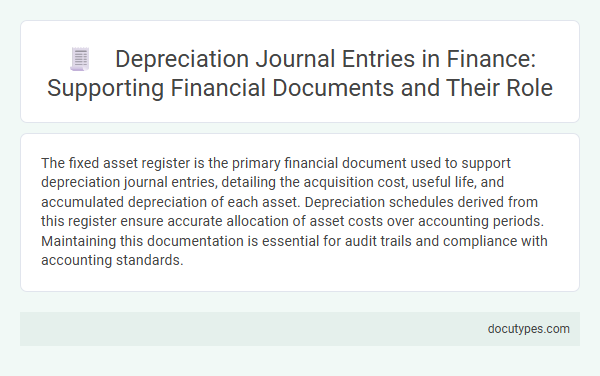The fixed asset register is the primary financial document used to support depreciation journal entries, detailing the acquisition cost, useful life, and accumulated depreciation of each asset. Depreciation schedules derived from this register ensure accurate allocation of asset costs over accounting periods. Maintaining this documentation is essential for audit trails and compliance with accounting standards.
Introduction to Depreciation Journal Entries in Finance
Depreciation journal entries are essential in accounting to allocate the cost of tangible assets over their useful lives. These entries help reflect the wear and tear or obsolescence of assets in financial records.
- Depreciation Schedule - A detailed document outlining the depreciation expense recognized for each asset over specific periods.
- Fixed Asset Register - Maintains records of all company assets, including acquisition dates, costs, and depreciation methods.
- Invoice and Purchase Documentation - Original documents supporting the asset's initial cost, necessary for accurate depreciation calculations.
The depreciation schedule is the primary financial document used to support and justify depreciation journal entries in finance.
Importance of Accurate Depreciation Records
Accurate depreciation journal entries rely on specific financial documents to ensure proper asset valuation and compliance. Your financial statements must reflect precise depreciation to maintain trustworthiness and support decision-making.
- Fixed Asset Register - This document records all company assets and details necessary for calculating depreciation, including purchase date and cost.
- Depreciation Schedule - It outlines the systematic allocation of an asset's cost over its useful life, guiding accurate journal entries.
- General Ledger Entries - These entries document depreciation expenses and accumulated depreciation, forming the basis for financial reporting and audits.
Types of Depreciation Methods and Their Entries
Understanding which financial document supports depreciation journal entries is essential for accurate accounting. You need to know the types of depreciation methods and how to record their entries correctly.
- Depreciation Schedule - This document details the asset's cost, useful life, salvage value, and accumulated depreciation to support journal entries.
- Straight-Line Depreciation - Charges an equal expense amount each period, recorded by debiting Depreciation Expense and crediting Accumulated Depreciation.
- Declining Balance Method - Accelerates expense in earlier years with higher depreciation, reflected through relevant journal entries based on the method's formula.
Key Financial Documents Supporting Depreciation
Which financial document is used to support depreciation journal entries? The fixed asset register is the primary document detailing asset cost, acquisition date, and useful life, essential for accurate depreciation calculation. Depreciation schedules provide a structured timeline of expense recognition, aligning with accounting policies and tax regulations.
Source Documents Required for Depreciation Accounting
Depreciation journal entries require source documents such as the fixed asset register, purchase invoices, and depreciation schedules. The fixed asset register provides detailed information on asset cost, acquisition date, and useful life, which are crucial for calculating depreciation. Purchase invoices verify asset cost, while depreciation schedules outline the systematic allocation of the asset's cost over its useful life.
Recording Depreciation in the General Ledger
The financial document used to support depreciation journal entries is the fixed asset register, which provides detailed information on asset cost, acquisition date, and useful life. Recording depreciation in the general ledger requires accurate entries based on data from the fixed asset register to ensure proper matching of expenses with revenue. Your depreciation journal entries reflect the systematic allocation of an asset's cost over time, supported by this critical documentation.
Audit Trail: Linking Documents to Journal Entries
The primary financial document used to support depreciation journal entries is the fixed asset register. This register details asset acquisition dates, costs, useful lives, and accumulated depreciation, forming the basis for accurate depreciation calculations.
Audit trails link depreciation journal entries to the fixed asset register to ensure transparency and accuracy. Supporting documents such as asset purchase invoices, asset disposal records, and depreciation schedules provide additional verification. These links enable auditors to trace each journal entry back to source documents, facilitating compliance and financial integrity.
Role of Supporting Documents in Compliance
| Financial Document | Purpose | Role in Supporting Depreciation Journal Entries | Compliance Importance |
|---|---|---|---|
| Fixed Asset Register | Records detailed information on all tangible fixed assets | Provides asset cost, acquisition date, useful life, and accumulated depreciation to calculate accurate depreciation expenses | Ensures depreciation entries are traceable and verifiable under accounting standards and audit requirements |
| Invoice or Purchase Order | Documents the initial acquisition cost of an asset | Validates the original cost basis for depreciation calculations, supporting journal entries | Maintains accuracy and legitimacy in asset valuation for financial reporting |
| Depreciation Schedules | Outlines depreciation expense allocation over the asset's useful life | Serves as the primary reference for recording monthly or annual depreciation journal entries | Facilitates compliance with GAAP, IFRS, and company policies by ensuring systematic expense recognition |
| Asset Disposal or Transfer Documents | Records asset write-offs, disposals, or transfers | Supports adjustments to depreciation and updates asset registers accurately | Prevents misstatement of asset values and depreciation expenses during audits |
| Audit Trails and Reconciliation Reports | Provides evidence of depreciation journal entry accuracy and completeness | Helps verify that journal entries align with supporting asset data and accounting policies | Strengthens internal controls and demonstrates adherence to regulatory requirements |
Your use of these supporting financial documents guarantees transparent, accurate depreciation journal entries while ensuring compliance with accounting standards and audit protocols.
Common Errors in Depreciation Documentation
Depreciation journal entries are typically supported by the asset's depreciation schedule or fixed asset register, which detail the cost, useful life, and accumulated depreciation. These documents provide essential data for accurate financial reporting and compliance with accounting standards.
Common errors in depreciation documentation include incorrect asset classification and inaccurate estimation of useful life, leading to misstated expenses. Failure to regularly update asset records or reconcile accumulated depreciation can result in discrepancies in financial statements.
Which Financial Document Is Used to Support Depreciation Journal Entries? Infographic

